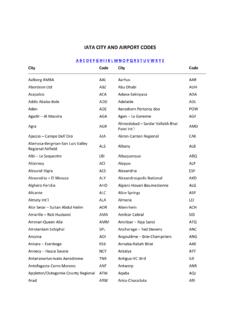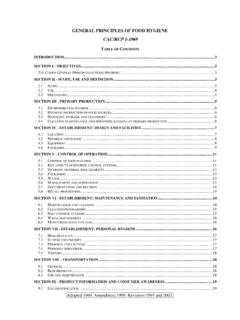Transcription of Sustainable food systems - Food and Agriculture Organization
1 Sustainable food systemsConcept and frameworkWHAT IS A Sustainable food system ? food systems (FS) encompass the entire range of actors and their interlinked value-adding activities involved in the production, aggregation, processing, distribution, consumption and disposal of food products that originate from Agriculture , forestry or fisheries, and parts of the broader economic, societal and natural environments in which they are food system is composed of sub- systems ( farming system , waste management system , input supply system , etc.) and interacts with other key systems ( energy system , trade system , health system , etc.)
2 Therefore, a structural change in the food system might originate from a change in another system ; for example, a policy promoting more biofuel in the energy system will have a significant impact on the food system . A Sustainable food system (SFS) is a food system that delivers food security and nutrition for all in such a way that the economic, social and environmental bases to generate food security and nutrition for future generations are not compromised. This means that: It is profitable throughout (economic sustainability); It has broad-based benefits for society (social sustainability); and It has a positive or neutral impact on the natural environment (environmental sustainability).
3 A Sustainable food system lies at the heart of the United Nations Sustainable Development Goals (SDGs). Adopted in 2015, the SDGs call for major transformations in Agriculture and food systems in order to end hunger, achieve food security and improve nutrition by 2030. To realize the SDGs, the global food system needs to be reshaped to be more productive, more inclusive of poor and marginalized populations, environmentally Sustainable and resilient, and able to deliver healthy and nutritious diets to all. These are complex and systemic challenges that require the combination of interconnected actions at the local, national, regional and global TAKE A food systems APPROACH?
4 CHANGING food SYSTEMSA food system must be considered in the context of rapid population growth, urbanization, growing wealth, changing consumption patterns, and globalization as well as climate change and the depletion of natural resources. The developments in food systems have yielded many positive results, especially over the past three decades in developing countries. These results include the expansion of off-farm employment opportunities as food industries have developed, and the widening of food choices beyond local staples, thus satisfying consumers preferences in terms of taste, form and quality. However, the associated rapid structural transformations have also resulted in increasing and significant challenges, with potentially wide-reaching consequences for the state of food security and nutrition.
5 These include the many highly processed, high-calorie and low nutritional value food items that are now widely available and consumed; limited access of small-scale producers and agri-enterprises to viable markets; high levels of food loss and waste; increased incidences of food safety, and animal and human health issues; and an increased energy-intensity and ecological footprint associated with the lengthening and industrialization of food supply , a better understanding of how a diverse range of food systems functions is critical to ensuring that these systems develop in such a way that minimizes their negative impacts and maximizes their positive contributions.
6 LIMITATIONS OF CURRENT APPROACHES The complexity of food systems requires a more holistic and coordinated approach. Many food security and nutrition challenges are complex problems whose solutions are contested and which transcend disciplinary, divisional, and institutional boundaries. In increasingly globalized food systems , these challenges result from interactions across different scales and levels. They require integrated actions taken by all stakeholders at local, national, regional, and global levels, by both public and private actors, and across multiple fronts- not only in Agriculture , but also in trade, policy, health, environment, gender norms, education, transport and infrastructure, and so on.
7 It requires a synergetic merging rather than a destructive clashing of the ideas emerging from these various food security programs tend to adopt a production-focused approach, which seeks to directly influence food security through increasing the supply of food . In a few regions of the world, particularly Sub-Saharan Africa, inadequate food production is still the major cause of food and nutrition insecurity. However, the dramatic pace of food system changes over the past decades has brought about complex interactions and feedback loops that impact food security and nutrition in many different ways. The focus on food production leads to the neglect of other areas in which the root causes of the food system underperformance, as well as the leverage points to bring about the biggest impacts can often be found.
8 Furthermore, the interwoven interactions and feedbacks in the food system mean that direct interventions in one area risk creating or exacerbating problems in another. Recently, other approaches that employ systems thinking have gained momentum. The value chain (VC) development approach, for instance, uses systems thinking to examine the way value is created and captured not only by producers, but also by other stakeholders, including workers, governments and consumers. Essentially, VC development emphasizes systemic analyses and integrated interventions to improve the chain s performance. The VC development approach nonetheless focuses on one particular commodity and therefore tends to overlook the interdependencies of different VCs.
9 Farmers, especially smallholders, often combine growing a variety of crops with livestock, fisheries and/or forestry activities, and the nutritional status of consumers depends on diets made up of multiple commodities. Achieving broad-based developmental impacts, thus, requires taking a broader look at the interactions of all food VCs at the food system level. Another increasingly popular approach- the market systems approach- recognizes markets as complex adaptive systems to address systemic constraints to market linkages that can affect multiple value chains (for instance, strengthening linkages to financial services for farmers). While it can overcome the VC approach s one chain at a time limitation, the market systems approach tends to be constrained to one market and as such subject to a similar narrow perspective challenge as the VC HOLISTICALLY A food systems approach is a way of thinking and doing that considers the food system in its totality, taking into account all the elements, their relationships and related effects.
10 It is not confined to one single sector, sub- system ( value chain, market) or discipline, and thus broadens the framing and analysis of a particular issue as the result of an intricate web of interlinked activities and feedbacks. It considers all relevant causal variables of a problem and all social, environmental, and economic impacts of the solutions to achieve transformational systemic changes. As such, the food systems approach addresses the limitations of many traditional approaches to improving food security and nutrition, which tend to be sectoral with either a narrowly defined focus that leads to technical fixes, which are subjected to the scope of one ministry or public agency, or which use systemic thinking to tackle objectives but are limited to sub- systems .














